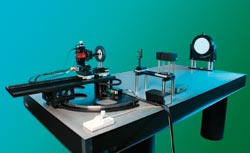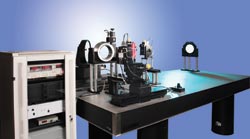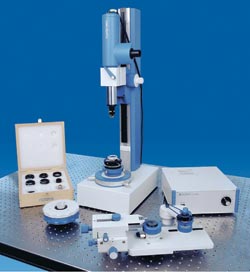Greek historian Xenophon said, “Fast is fine, but accuracy is everything.” This could be the guiding principle of companies working in the field of lens testing and measurement.
The performance of lenses has been increasing over recent years, driven by the demands of applications such as HD television and high-resolution digital cameras and enabled by the expanding use of aspheric surfaces and sophisticated optical design software. The need for testing lenses quickly and accurately in production is therefore greater now than ever. At one extreme are the small lenses used in mobile phones. These lenses can have quite exotic designs and are made from injection-moulded plastic elements to control costs. They are produced in enormous quantities but nevertheless must be tested on an individual basis, which presents a serious challenge.

Shown is a visible MTF test bench. Photos courtesy of Image Science.
The modulation transfer function (MTF) is a basic and valuable parameter used to facilitate the objective evaluation of the image-forming capability of an optical system. It measures the ability of an optical system to reproduce (transfer) various levels of detail from object to image. Performance is measured in terms of contrast (modulation) in the image as a function of the frequency of a sine wave test chart.
The MTF can be calculated from the lens design data, allowing optical and systems designers to determine the performance of optical systems. The image quality of the manufactured lenses can be compared with design expectations. Performance improvements in devices such as the laser interferometer, the CCD camera and the computer have transformed the calculation of the MTF into a nearly instantaneous measurement.
Although there are a variety of test systems available to evaluate optics, the operating principles of each system are similar. The lens being tested is mounted between a video microscope and a collimated light source. The light source presents an image of a test reticule to the lens under test, and the resulting image is captured by the camera in the video microscope.

Shown is an infrared MTF test bench.
The image will be slightly degraded as a result of unavoidable aberrations and diffraction phenomena. Manufacturing and alignment errors in the optics will adversely affect the overall imaging performance of the system: Bright highlights in the image will not appear as bright as they do in the object, and dark or shadowed areas will not be as black as those observed in the original patterns.
Two companies working in this field are Trioptics GmbH of Germany and Image Science Ltd. of the UK. Trioptics offers a system called OptiSpheric, a universal optical test station that automatically measures optical parameters such as effective focal length, MTF, and back focal length of lenses with diameters from 2 to 200 mm and effective focal length from 1 to ~2000 mm. Optional upgrades to the software and accessories enable measurement of centring errors in transmission and reflection and permit the alignment or cementing of optics. To meet the needs of customers who test large quantities of lenses in a production environment, Trioptics has developed an OptiSpheric station incorporating an automated tray system with seats for 30 or 60 lenses and a fully automated measurement procedure.

The OptiSpheric with mechanical focusing stage and accessories for centration measurement. Photo courtesy of Trioptics.
Image Science offers a range of customized MTF benches, and it specializes in testing high-end optics and infrared lenses. Image Science systems are used to test lenses ranging from digital cameras to land-surveying satellite-based lenses and aerial mapping lenses on aircraft. On the defence side, their systems test lenses for night-vision systems and for infrared thermal imaging systems. They recently developed a system for the military to test a highly specialized infrared lens used for target detection and tracking. Image Science also collaborates with Nanotex Corp. of Japan to produce custom production systems for Japanese lens manufacturers.
When Kevin Urben, Image Science’s managing director, began working in the field, he programmed MTF software using a microcomputer with a 1-MHz, 8-bit processor. Today’s desktop computers are roughly 10,000 times faster than this. The increased speed allows for more calculations to be made and for those calculations to be more complex, making the entire system much more efficient.
Camera technology also is advancing, which enables the analysis of more complex targets in real time. The number of pixels has increased, and the signal-to-noise ratio has improved, enabling improved analysis in close to real time. These advances will aid systems designers in developing increasingly sophisticated measurement systems in the future.
Trioptics GmbH
www.trioptics.com
Image Science Ltd.
www.image-science.co.uk
Nanotex Corp.
www.nanotex-jp.com